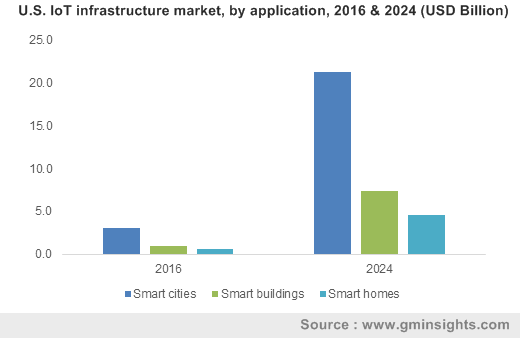IoT infrastructure market to generate substantial proceeds by 2024, driven by the extensive development of smart cities
Publisher : Fractovia | Published Date : October 2017Request Sample
The advent of connected technology has conveniently changed the landscape of IoT infrastructure market in recent times. The internet of things, since its inception, has already had a positive impact on several end-use sectors such as transportation, agriculture, and healthcare. It is however being forecast, that in the many decades to come, practically every business would be connected through IoT. One of the many business spheres making rapid inroads in the IoT domain is infrastructural development. With the robust increase in consumer standards of living and the subsequent demand for deluxe residential and commercial arenas, experts predict IoT infrastructure market size to scale appreciable heights of success in the years ahead. A research study undertaken by Global Market Insights, Inc., estimates IoT infrastructure industry size to surpass USD 130 billion by the end of 2024.
U.S. IoT infrastructure market, by application, 2016 & 2024 (USD Billion)

The trend of urbanization has led to an increase in the populace across cities, pertaining to the easy availability of several facilities such as advanced healthcare, transportation, and housing. The rapidly increasing population has adversely affected the municipal infrastructure, on account of which various municipalities have commenced the deployment of IoT in public infrastructure. Reportedly, this move has been undertaken in a bid to deal with the surging population pressure and the enhanced consumer living standards, and is expected to significantly boost IoT infrastructure industry share. A proportionate number of regional governments have begun to implement the internet of things for addressing smart governance, smart living, smart economy, smart cities, and smart mobility. Outlined underneath are some of the aspects of smart cities affecting the IoT infrastructure market outlook:
Impact of principal policies of smart city on IoT infrastructure market share
The development of smart technologies has been transforming the lives of the urban populace, subject to the determinants of comfort living, sustainability, energy efficiency, and convenience. In order to ensure that smart cities deliver what is expected, various organizations such as the ITI (Information Technology Industry Council) have been looking forward to implementing a few essential policies through public-private alliances. Some of the policy principles are mentioned right below:
- Sustainability policies and plans: Governmental bodies mandating norms for sustainability would need to consider that smart cities would contribute substantially toward perpetuating sustainability trends. For instance, the deployment of ICTs (information and communications technology) and ITSs (intelligent transportation systems) would markedly lower traffic jams and enhance the overall transportation systems, which would contribute toward an environment-friendly conveyance, while simultaneously providing a boost to IoT infrastructure industry share. In consequence, major regulatory bodies plan to develop smart building technologies, energy storage technologies, and renewable power generation. With the assistance of IoT, municipal authorities would also now efficiently monitor waste production, energy consumption, and transportation, which will considerably propel IoT infrastructure industry share.
- Encourage industry-led standards & practices: This policy demands the private sector to lead the development of open standards for enabling interoperability, while it demands the public sector to promote sharing best practices and standards. The deployment of this policy would help to enable cost-effective introduction of novel technologies and would deliver plug-and-play interoperability for quick, cost-efficient upgrades. The standardization of security systems in smart cities will thus stimulate IoT infrastructure market trends.
- Encourage innovation and investment: Through this policy, regional governments would be expected to promote numerous investments and innovations by executing strategic collaborations with research institutes and core companies. In order to comply with various infrastructure development norms, major companies have been investing heavily in the development of modern, state-of-the-art infrastructure, which eventually provide a boost to IoT infrastructure market size.
- Invest in next-gen technologies and internet infrastructure: As per estimates, by 2020, nearly 50 billion devices are expected to be connected to the internet, which would be essential for the development of smart cities in the near future. In a bid to enhance consumer lifestyle, municipalities have been rapidly deploying 5G technology to upgrade the broadband network infrastructure, which would transform IoT infrastructure industry outlook over the years ahead.
Mapping of smart cities across the European Union to boost IoT infrastructure market share
The member countries of the European Union inclusive of UK, Italy, Spain, Austria, Norway, Slovenia, Sweden, and Estonia have taken initiatives to strengthen their living standards, governance policies, and economic growth through the development of smart cities, by 2020. EU’s strategy for generating lucrative job opportunities and improving the economic growth across Europe through sustainable and smart technology deployment is certain to have a vital influence on Europe IoT infrastructure market.
Apart from Europe, the governments across Asia Pacific have also been stringently involved in the development of smart cities. For instance, merely a couple of years back, the Ministry of Housing and Urban Affairs announced a ‘Smart cities’ mission, which will favorably influence APAC IoT infrastructure industry share.
The robustly increasing requirement for a luxurious, high-end lifestyle and enhanced living quarters is anticipated to perpetually accelerate the growth rate of IoT infrastructure market. Leading behemoths such as Microsoft Corporation, Huawei Technologies Inc., IBM Corporation, Schneider Electric, and Intel Corporation have also been earnestly attempting to increase the product penetration across numerous application arenas. The deployment of government initiatives for the adoption of connected devices in infrastructural development has been touted to play a major role in the development of IoT infrastructure market, slated to grow at a rate of 25% over 2017-2024.